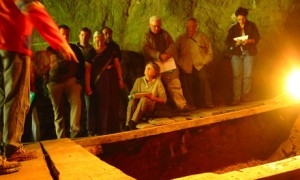
The missing human relatives are thought to have inhabited much of Asia as recently as 30,000 years ago, and so shared the land with early modern humans and Neanderthals.
The finding paints a complex picture of human history in which our early ancestors left Africa 70,000 years ago to rub shoulders with other distant relatives in addition to the stocky, barrel-chested Neanderthals.
The new ancestors have been named “Denisovans” after the Denisova cave in the Altai mountains of southern Siberia where the finger bone was unearthed in 2008. Field workers excavating the site have found various stone tools and bones that suggest the cave was occupied by early humans for 125,000 years.
Now this next bit is interesting …
The greatest surprise came when the team compared DNA from Denisovans and modern humans. This revealed that the Denisovans had genetic material in common with modern populations in Papua New Guinea, due to interbreeding with ancestors of the Melanesians. Previously, Pääbo’s group has reported evidence for interbreeding between Neanderthals and the ancestors of non-Africans alive today.
“What is interesting is that at the time when Neanderthals existed in western Eurasia, there was this other group with a distinct history that was presumably widespread in east Asia,” Pääbo told the Guardian. “We are now starting to get a more comprehensive picture of them. We want to know, who were the archaic people that were there and that modern humans met when they came out of Africa?”
Its truly fascinating to learn that there was lots of diversity out there, an assortment of different smart apes all competing.
There is lots more information in the Guardian article, to read just click here.